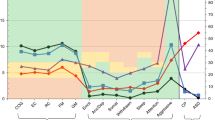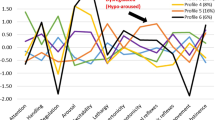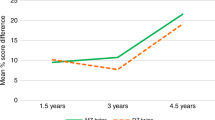Abstract
Background
Very preterm infants are at high risk for neurodevelopmental impairments. We used a child-centered approach (latent profile analysis [LPA]) to describe 2-year neurobehavioral profiles for very preterm infants based on cognitive, motor, and behavioral outcomes. We hypothesized that distinct outcome profiles would differ in the severity and co-occurrence of neurodevelopmental and behavioral impairment.
Methods
We studied children born <33 weeks’ gestation from the Environmental influences on Child Health Outcomes Program with at least one neurobehavioral assessment at age 2 (Bayley Scales of Infant and Toddler Development, Child Behavior Checklist, Modified Checklist for Autism in Toddlers, cerebral palsy diagnosis). We applied LPA to identify subgroups of children with different patterns of outcomes.
Results
In 2036 children (52% male; 48% female), we found four distinct neurobehavioral profiles. Most children (~85%) were categorized into one of two profiles characterized by no/mild neurodevelopmental delay and a low prevalence of behavioral problems. Fewer children (~15%) fell into one of two profiles characterized by severe neurodevelopmental impairments. One profile consisted of children (5%) with co-occurring neurodevelopmental impairment and behavioral problems.
Conclusion
Child-centered approaches provide a comprehensive, parsimonious description of neurodevelopment following preterm birth and can be useful for clinical and research purposes.
Impact
-
Most research on outcomes for children born very preterm have reported rates of impairment in single domains.
-
Child-centered approaches describe profiles of children with unique combinations of cognitive, motor, and behavioral strengths and weaknesses.
-
We capitalized on data from the nationwide Environmental influences on Child Health Outcomes Program to examine these profiles in a large sample of children born <33 weeks gestational age.
-
We found four distinct neurobehavioral profiles consisting of different combinations of cognitive, motor, and behavioral characteristics.
-
This information could aid in the development of clinical interventions that target different profiles of children with unique developmental needs.
This is a preview of subscription content, access via your institution
Access options
Subscribe to this journal
Receive 14 print issues and online access
$259.00 per year
only $18.50 per issue
Buy this article
- Purchase on Springer Link
- Instant access to full article PDF
Prices may be subject to local taxes which are calculated during checkout

Similar content being viewed by others
Data availability
De-identified data from the ECHO Program are available through NICHD’s Data and Specimen Hub (DASH) (https://dash.nichd.nih.gov). DASH is a centralized resource that allows researchers to access data from various studies via a controlled-access mechanism. Researchers can now request access to these data by creating a DASH account and submitting a Data Request Form. The NICHD DASH Data Access Committee will review the request and provide a response in approximately 2–3 weeks. Once granted access, researchers will be able to use the data for 3 years. See the DASH Tutorial for more detailed information on the process (https://dash.nichd.nih.gov/resource/tutorial).
References
Glass, H. C. et al. Outcomes for extremely premature infants. Anesth. Analg. 120, 1337–1351 (2015).
Vohr, B. R. Neurodevelopmental outcomes of extremely low birth weight infants <32 weeks’ gestation between 1993 and 1998. Pediatrics 116, 635–643 (2005).
Cheong, J. L. Y. et al. Changing neurodevelopment at 8 years in children born extremely preterm since the 1990s. Pediatrics 139, e20164086 (2017).
Burnett, A. C. et al. Trends in executive functioning in extremely preterm children across 3 birth eras. Pediatrics 141, e20171958 (2018).
Allen, M. C. Neurodevelopmental outcomes of preterm infants. Curr. Opin. Neurol. 21, 123–128 (2008).
Adams-Chapman, I. et al. Neurodevelopmental impairment among extremely preterm infants in the neonatal research network. Pediatrics 141, e20173091 (2018).
Camerota, M. et al. Neurodevelopmental profiles of infants born <30 weeks gestation at 2 years of age. Pediatr. Res. 91, 1579–1586 (2022).
Heeren, T. et al. Cognitive functioning at the age of 10 years among children born extremely preterm: a latent profile approach. Pediatr. Res. 82, 614–619 (2017).
Burnett, A. C. et al. Exploring the “preterm behavioral phenotype” in children born extremely preterm. J. Dev. Behav. Pediatr. 40, 200–207 (2019).
Cserjesi, R. et al. Patterns of functioning and predictive factors in children born moderately preterm or at term. Dev. Med. Child Neurol. 54, 710–715 (2012).
McGowan, E. C. et al. Analysis of neonatal neurobehavior and developmental outcomes among preterm infants. JAMA Netw. Open 5, e2222249 (2022).
Gillman, M. W. & Blaisdell, C. J. Environmental influences on child health outcomes, a research program of the National Institutes of Health. Curr. Opin. Pediatr. 30, 260–262 (2018).
Blackwell, C. K., Wakschlag, L. S., Gershon, R. C. & Cella, D. Measurement framework for the Environmental influences on Child Health Outcomes research program. Curr. Opin. Pediatr. 30, 276–284 (2018).
Jacobson, L. P., Lau, B., Catellier, D. & Parker, C. B. An Environmental influences on Child Health Outcomes viewpoint of data analysis centers for collaborative study designs. Curr. Opin. Pediatr. 30, 269–275 (2018).
O’Shea T. M., et al. Environmental influences on Child Health Outcomes: cohorts of individuals born very preterm. Pediatr. Res. 93, 1161–1176. https://doi.org/10.1038/s41390-022-02230-5 (2023).
Bayley, N. Bayley Scales of Infant Development (Harcourt Assessment, 2006).
Moore, T., Johnson, S., Haider, S., Hennessy, E. & Marlow, N. Relationship between test scores using the second and third editions of the Bayley scales in extremely preterm children. J. Pediatr. 160, 553–558 (2012).
Lin, Y. C. et al. Postnatal serum total thyroxine of very preterm infants and long-term neurodevelopmental outcome. Nutrients 13, 1055 (2021).
Plomgaard, A. M. et al. No neurodevelopmental benefit of cerebral oximetry in the first randomised trial (SafeBoosC II) in preterm infants during the first days of life. Acta Paediatr. 108, 275–281 (2019).
Achenbach, T. & Rescorla, L. Manual for the ASEBA Preschool Forms & Profiles (University of Vermont, 2000).
Palisano, R. et al. Development and reliability of a system to classify gross motor function in children with cerebral palsy. Dev. Med. Child Neurol. 39, 214–223 (2008).
Kuban, K. C. K. et al. An algorithm for identifying and classifying cerebral palsy in young children. J. Pediatr. 153, 466–472.e1 (2008).
Robins, D. L., Fein, D., Barton, M. L. & Green, J. A. The Modified Checklist for Autism in Toddlers: an initial study investigating the early detection of autism and pervasive developmental disorders. J. Autism Dev. Disord. 31, 131–144 (2001).
Robins, D. L. et al. Validation of the Modified Checklist for Autism in Toddlers, Revised With Follow-up (M-CHAT-R/F). Pediatrics 133, 37–45 (2014).
Acknowledgements
The authors wish to thank our ECHO colleagues; the medical, nursing, and program staff; and the children and families participating in the ECHO cohorts. We also acknowledge the contribution of the ECHO program collaborators.
Funding
Research reported in this publication was supported by the Environmental influences on Child Health Outcomes (ECHO) program, Office of the Director, National Institutes of Health, under Award Numbers U2COD023375 (Coordinating Center), U24OD023382 (Data Analysis Center), U24OD023319 with co-funding from the Office of Behavioral and Social Science Research (PRO Core), UH3OD023320 (Aschner), UH3OD023347 (Lester), UH3OD023348 (O’Shea). M.C. was additionally supported by a career development award from the National Institute of Mental Health (NIMH), grant K01MH129510 (Camerota). The content is solely the responsibility of the authors and does not necessarily represent the official views of the National Institutes of Health.
Author information
Authors and Affiliations
Consortia
Contributions
Conception and design of study: M.C., B.M.L. Acquisition of data: J.A., A.S., B.S.C., J.C., J.B.H., C.R.N., T.M.O.S., S.L.P., L.M.S., B.M.L. Analysis and interpretation of data: M.C. Drafting the article: M.C. Revising article critically for important intellectual content: M.C., E.C.M., J.A., A.S., T.M.O.S., J.A.H., R.M.J., R.M., G.T., B.S.C., J.C., L.M.D., S.G., J.B.H., C.R.N., S.L.P., L.M.S., C.J.M., B.M.L. Final approval of the version as submitted: M.C., E.C.M., J.A., A.S., T.M.O.S., J.A.H., R.M.J., R.M., G.T., B.S.C., J.C., L.M.D., S.G., J.B.H., C.R.N., S.L.P., L.M.S., C.J.M., B.M.L.
Corresponding author
Ethics declarations
Competing interests
The authors declare no competing interests.
Ethics approval and consent to participate
This study was approved by local Institutional Review Boards, and participants gave informed consent.
Additional information
Publisher’s note Springer Nature remains neutral with regard to jurisdictional claims in published maps and institutional affiliations.
Supplementary information
Rights and permissions
Springer Nature or its licensor (e.g. a society or other partner) holds exclusive rights to this article under a publishing agreement with the author(s) or other rightsholder(s); author self-archiving of the accepted manuscript version of this article is solely governed by the terms of such publishing agreement and applicable law.
About this article
Cite this article
Camerota, M., McGowan, E.C., Aschner, J. et al. Neurodevelopmental and behavioral outcomes of very preterm infants: latent profile analysis in the Environmental influences on Child Health Outcomes (ECHO) Program. Pediatr Res 95, 377–385 (2024). https://doi.org/10.1038/s41390-023-02814-9
Received:
Revised:
Accepted:
Published:
Issue Date:
DOI: https://doi.org/10.1038/s41390-023-02814-9



